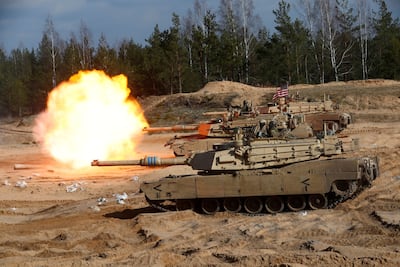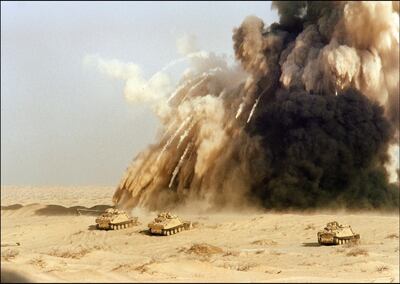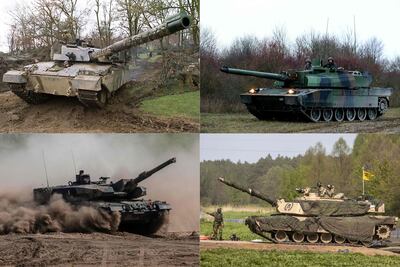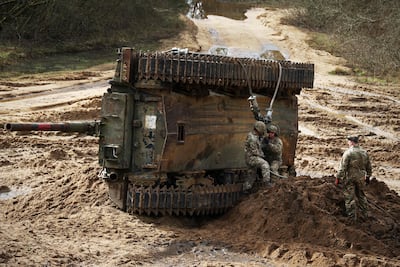Nato armour was designed to overcome one major problem ― how do you win a war against an enemy that may have three times as many tanks as you?
During the Cold War, the Soviet Union deployed 20,000 tanks near the West German border, facing off against about a third the number of Nato tanks.
So, in the 1970s, western designers and strategists grappled with the need for a tank that was highly mobile, heavily armoured and powerfully armed.
A US report described the requirement being for “rapid engagement of successive targets.”
From the MBT-70 to the M1 Abrams

Today, Germany's Leopard 2 and America's US M1 Abrams evolved, in part, from a joint tank development programme in the 1960s and '70s aimed at building a strong all-round tank. It yielded the MBT-70, a weapon that outclassed its Russian adversary in manoeuvrability, armour and armament.
While the MBT-70 was abandoned due to cost, the Nato militaries had tanks that they felt could tackle a much larger number of Soviet opponents with heavier guns and the ability to launch anti-tank missiles.
“One would expect a Challenger II to be able to take two or three direct hits from a T-72 or T-80 and still carry on, and the armour, which is highly classified, is designed to do that,” Col Hamish De Bretton-Gordon, who commanded Challenger I tanks during the first Gulf war, and later Challenger 2s in peacetime.
Russia is still fielding T-72s and T-80s in Ukraine alongside their most advanced T-90 tanks.
In pictures: Nato equipment in Ukraine

















But, it was not until Operation Desert Storm in the 1990s that the British and Americans would put their Challengers and M1 Abrams to the test against the largely Soviet-made T-72s of Saddam Hussein's Iraq.
In 1991, a Challenger 1 ― a less well-armoured version of the modern Challenger II ― destroyed an Iraqi tank at a range of at least 4,700 metres, still thought to be the longest-range tank kill in history.

The US and American tanks proved better than expected ― even with the challenges presented by the hot, dusty deserts.
Between the first Gulf War in 1991 and the 2003 invasion of Iraq, British Challengers destroyed more than 300 enemy tanks and suffered no combat losses.
The M1 Abrams reported similarly long-range engagements over the flat terrain of Iraq’s southern desert, destroying around 160 Iraqi tanks with no combat losses at the battle of 73 Easting in February 1991.
While many of those Iraqi tanks were older Soviet designs, it buoyed hopes that the development of an agile but powerful tank able to beat overwhelming numbers had been a success.
Ukraine's tanks will again be outnumbered

As their designers envisaged, the donated tanks in Ukraine will be outnumbered by their Russian rivals.
Before the Ukraine invasion, Russia had approximately 2,600 operational tanks and 10,000 in storage, in varying states of repair.
These include Moscow's top battle tank, the T-90, but larger numbers of older T-80s and T-72s — many of them produced during the Cold War or shortly after. While the T-90s come with sophisticated electronics and targeting systems, the T-80s and T-72s are less advanced.
Since the war began last February, about half of Russia’s operational tanks are thought to have been lost, leaving an estimated 1,300.
From the flat dust of Iraq to the muddy fields of Europe

In contrast to the large flat plains of southern Iraq, Nato expected that fighting on the hills and in the forests of Europe would be at much shorter ranges.
One military analyst described much of the terrain in Ukraine as “close” and “complex,” with many places an enemy can conceal themselves.
Tank armour subsequently becomes more important, along with the ability to spot the enemy and fire the first shots.
Designed to overcome the odds, Nato tanks are proficient in exactly this kind of fighting, being fitted with powerful laser rangefinders, gun sights and thermal imaging systems that can spot enemies in gloomy conditions.
And while the Nato handbooks have been focused on how to win a war against the Soviet Union and then Russia for half a century, a British defence consultant said that Ukrainians themselves will ultimately find the best way to use these weapons.
“As for engagement range, the pace of adaptation and agility of response among the Ukrainian armed forces against the Russians has meant that many of the operating procedures and conventional tactics that might be assumed for the Challenger’s original use will be replaced by the Ukrainians’ approach,” he said.
“The success of the equipment will depend on the approach of the tank crews and their commanders, and the tanks' integration with other battlefield assets.”











